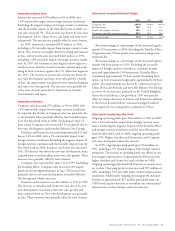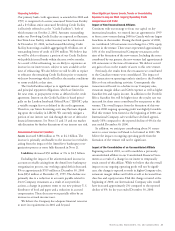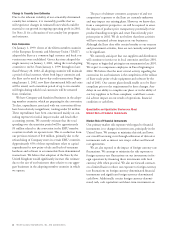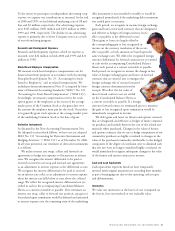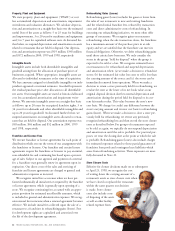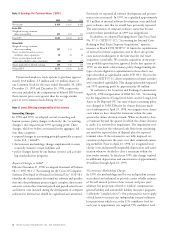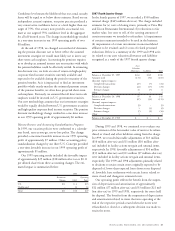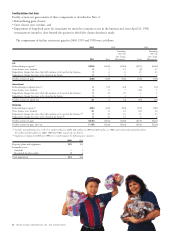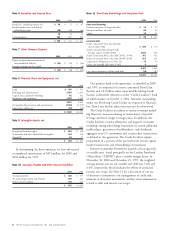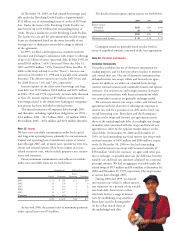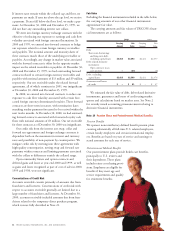Pizza Hut 2000 Annual Report Download - page 46
Download and view the complete annual report
Please find page 46 of the 2000 Pizza Hut annual report below. You can navigate through the pages in the report by either clicking on the pages listed below, or by using the keyword search tool below to find specific information within the annual report.
44 TRICON GLOBAL RESTAURANTS, INC. AND SUBSIDIARIES
Note 1 Description of Business
TRICON Global Restaurants, Inc. and Subsidiaries (collectively
referred to as “TRICON” or the “Company”) is comprised
of the worldwide operations of KFC, Pizza Hut and Taco Bell
(the “Concepts”) and is the world’s largest quick service
restaurant company based on the number of system units,
with over 30,000 units in over 100 countries and territories.
Approximately 34% of our system units are located outside the
U.S. References to TRICON throughout these Consolidated
Financial Statements are made using the first person notations
of “we,” “us” or “our.” Through our widely-recognized
Concepts, TRICON develops, operates, franchises and licenses
a system of both traditional and non-traditional quick service
restaurants. Our traditional restaurants feature dine-in, carry-
out and, in some instances, drive-thru or delivery service.
Non-traditional units, which are principally licensed outlets,
include express units and kiosks which have a more limited
menu and operate in non-traditional locations like airports,
gasoline service stations, convenience stores, stadiums,
amusement parks and colleges, where a full-scale traditional
outlet would not be practical or efficient. Each Concept has
proprietary menu items and emphasizes the preparation of
food with high quality ingredients as well as unique recipes
and special seasonings to provide appealing, tasty and attrac-
tive food at competitive prices.
We also previously operated other restaurant businesses
which were disposed of in 1997, which included California
Pizza Kitchen, Chevys Mexican Restaurant, D’Angelo’s
Sandwich Shops, East Side Mario’s and Hot ’n Now (collec-
tively, the “Non-core Businesses”).
Note 2 Summary of Significant Accounting Policies
Our preparation of the accompanying Consolidated Financial
Statements in conformity with accounting principles generally
accepted in the U.S. requires us to make estimates and assump-
tions that affect reported amounts of assets and liabilities,
disclosure of contingent assets and liabilities at the date of the
financial statements, and the reported amounts of revenues
and expenses during the reporting period. Actual results
could differ from the estimates.
Principles of Consolidation and Basis of Preparation
TRICON was created as an independent, publicly owned
company on October 6, 1997 (the “Spin-off Date”) via a
tax-free distribution by our former parent, PepsiCo, Inc.
(“PepsiCo”), of our Common Stock (the “Distribution”
or “Spin-off”) to its shareholders. Intercompany accounts
and transactions have been eliminated. Investments in
unconsolidated affiliates in which we exercise significant
influence but do not control are accounted for by the equity
method. Our share of the net income or loss of those uncon-
solidated affiliates and net foreign exchange gains or losses
are included in other (income) expense.
Internal Development Costs and Abandoned Site Costs
We capitalize direct costs associated with the site acquisition
and construction of a Company unit on that site, including
direct internal payroll and payroll-related costs and direct
external costs. Only those site-specific costs incurred subse-
quent to the time that the site acquisition is considered
probable are capitalized. We consider acquisition probable
upon final site approval. If we subsequently make a determi-
nation that a site for which internal development costs have
been capitalized will not be acquired or developed, any previ-
ously capitalized internal development costs are expensed at
this date and included in general and administrative expenses.
Fiscal Year
Our fiscal year ends on the last Saturday in December and,
as a result, a fifty-third week is added every five or six years.
Fiscal year 2000 included 53 weeks. Fiscal years 1999 and
1998 included 52 weeks. The first three quarters of each fiscal
year consist of 12 weeks and the fourth quarter consists of
17 weeks in fiscal years with 53 weeks and 16 weeks in fiscal
years with 52 weeks. Our subsidiaries operate on similar fiscal
calendars with period end dates suited to their businesses.
Period end dates are within one week of TRICON’s period
end date with the exception of our international businesses,
which close one period or one month earlier to facilitate
consolidated reporting.
Direct Marketing Costs
We report substantially all of our direct marketing costs in
occupancy and other operating expenses. We
charge direct marketing costs to expense ratably
in relation to revenues over the year in which
incurred and, in the case of advertising pro-
duction costs, in the year first shown. Deferred
direct marketing costs, which are classified as
prepaid expenses, consist of media and
related advertising production costs
which will generally be used for the
first time in the next fiscal year.
Notes to Consolidated Financial Statements
(tabular amounts in millions, except share data)



